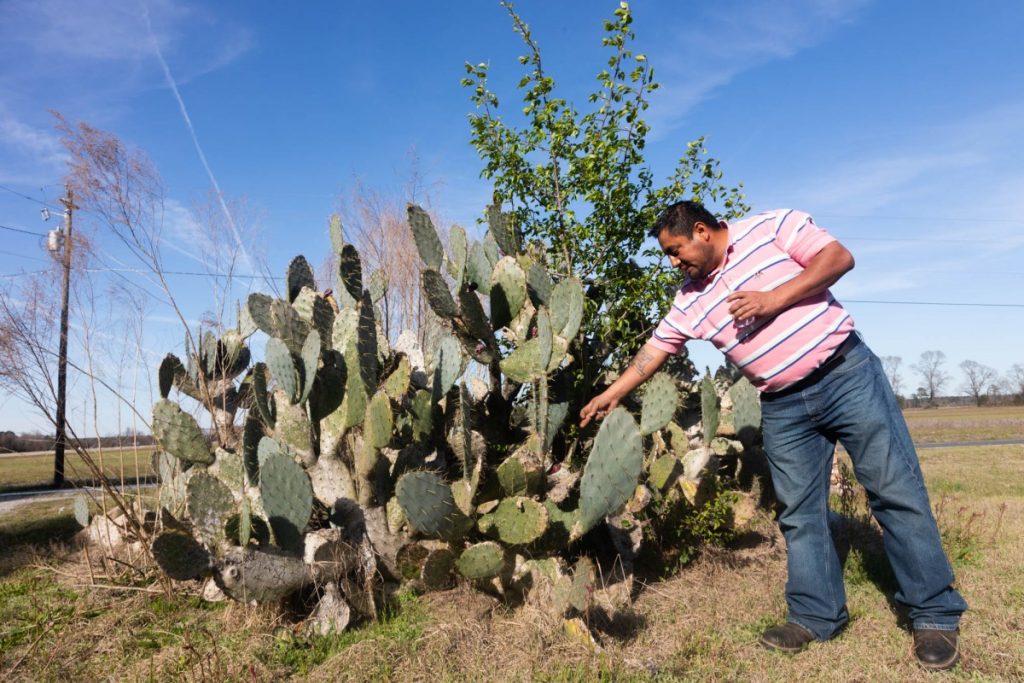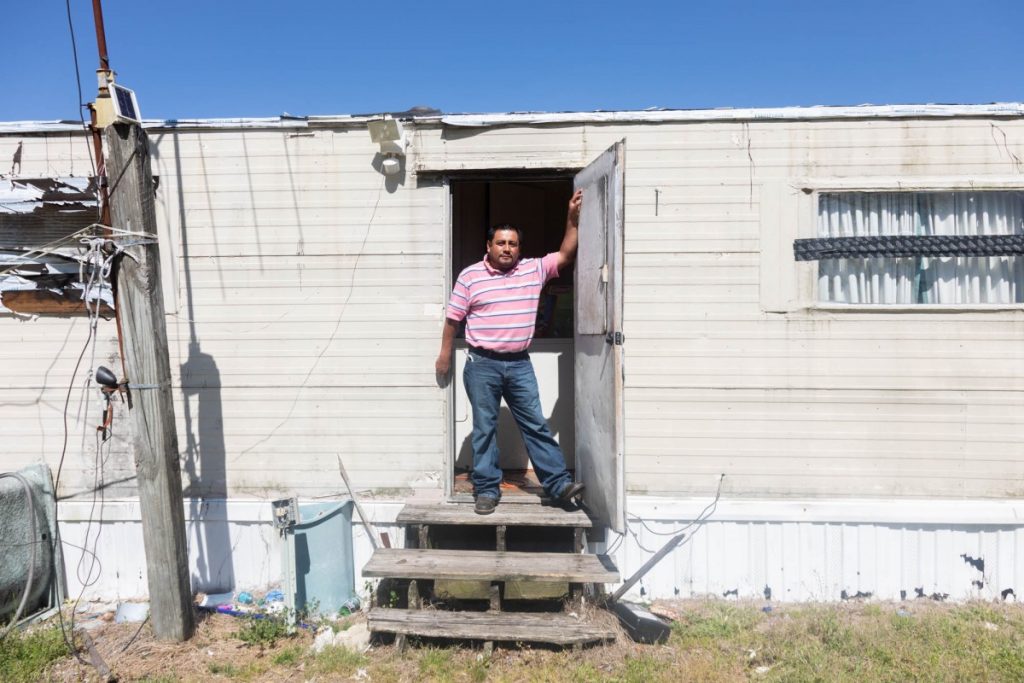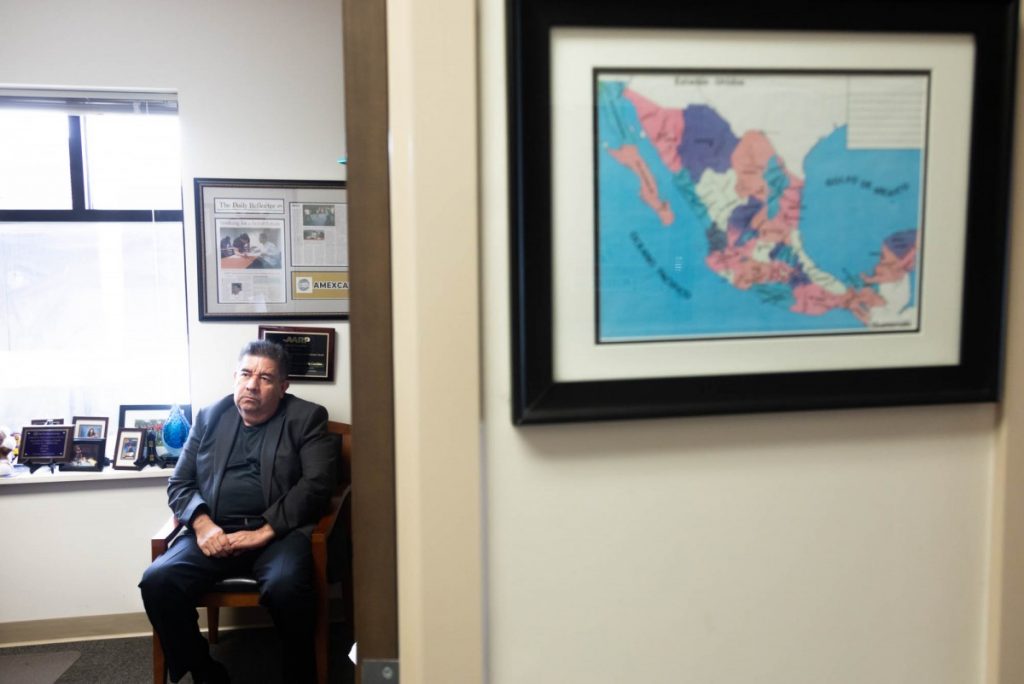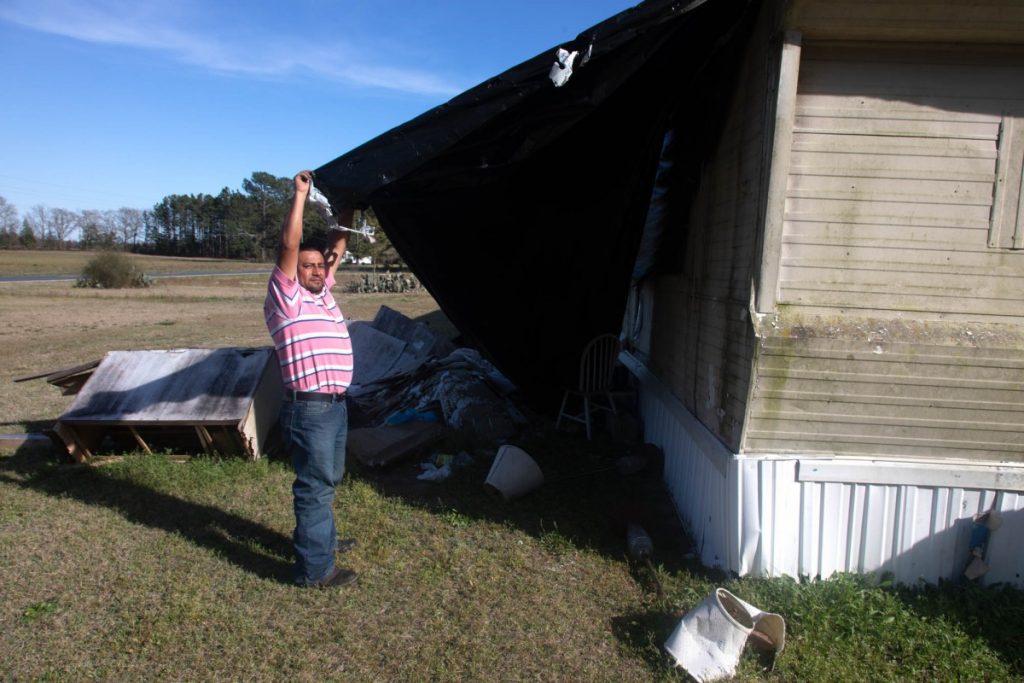They shouldn’t even be there, but there they are.
Beside a turnoff from a country road, in the middle of North Carolina’s tobacco country, you can’t miss the anarchic spread of Nopales, the cactus conspicuous in its spiky, stubborn survival.
Martin Hernández stands in front of them, narrating their history and that of his family’s 40-plus years in the United States, which are one and the same.
About three decades ago, one of his uncles brought a tuna, or pad, from Celaya, Guanajuato, in the center of Mexico, and stuck it in the ground. His uncle had already been coming back and forth for about 13 years to work the state’s tobacco, sweet potato and other crops.

That same uncle is now in his 60s, too old to continue crossing the border illegally; he’s back in Celaya. But over the years, dozens of family members and friends have made the small plot of land and trailer about 30 feet away from the Nopales their first stop enroute to a new life in the United States, while the cactus continued staking claim to eastern North Carolina’s rich, black soil.
Hernández arrived 12 years ago; he’s seen up to 10 people share the trailer. In recent years, it was him, his wife and her two children.
But that’s all over now. The Nopales are all that’s left as of about 6:30 on a Friday morning last September, when Hurricane Florence ripped through the field, flipping the roof off of Hernández’s trailer and destroying most of the family’s belongings. Hernández had sent his family to stay with relatives in Maryland several days before, and stayed alone in the trailer until about 5 a.m., when the “walls started shaking …and I thought, ‘I’m going to die here.’”
The hurricane also took away much of his work, ruining crops in its wake. Now his wife and children are with family in Maryland, as Hernández holds onto a life he never imagined for himself in the United States, living off of occasional jobs and the charity of strangers.
He is ineligible for any state or federal assistance, since his name is not on ownership documents for the trailer; working only half as much as in recent years, he won’t be able to afford his family living under one roof any time soon.
“If you look at a lot of disaster assistance, it’s based on ownership of a home or business,” said Scott Marlow, senior policy director at the Rural Advancement Foundation International (RAFI), a North Carolina-based nonprofit organization. “People without documents are going to have a much more difficult time accessing these programs.”
Hernández’s situation is not unlike the tens of thousands of undocumented farmworkers that help make North Carolina the nation’s top grower of sweet potatoes, second in Christmas trees and third in strawberries. Undocumented farmworkers and workers with temporary, H-2A visas, are also vital to agricultural industries in other Appalachian states such as Georgia, Tennessee and Kentucky. These farmworkers are uniquely vulnerable and mostly overlooked during and after extreme weather events such as Hurricane Florence.

Scientists say such events are linked to climate change and will likely be an increasingly common feature of life in many parts of the Southeast. From 1980 to 1990, for example, North Carolina suffered two severe storms causing more than a billion dollars in damage; since 2010, that number is already at 20, according to the National Oceanic and Atmospheric Administration. Last year’s Hurricane Florence was the 9th-most economically destructive hurricane in U.S. history, according to the same agency, including an estimated $1.1 billion in crop and livestock losses alone.
Throughout the decades Hernández’s family has lived in eastern North Carolina, thousands of undocumented farmworkers have settled in the region, transforming many towns in the agricultural center of the state into Spanish-speaking hubs. Indeed, “with some towns, if it weren’t for immigrants, they would disappear entirely from the map,” said Juvencio Rocha Peralta, executive director of the Association of Mexicans in North Carolina (AMEXCAN) and a North Carolina resident for nearly 40 years.
Pink Hill, where Hernández has lived all these years, is a perfect example. By 2017, according to most recent Census Bureau estimates, the town had shrunk by nearly 100 residents since 2000, to 433 total; but during that time, the number of Hispanic residents had remained about the same, now at 15.5 percent of the total population. It’s no surprise that two of the handful of restaurants in the center of town are Mexican.
New undocumented immigrant farmworkers continue to arrive in North Carolina and the state’s growers depend on increasing numbers of farmworkers with temporary, H-2A visas, mostly from the same countries as undocumented farmworkers.
Despite their importance to the regional economy, these workers remain mostly unseen when natural disasters strike. The reason: both populations “… are valued less than crops, after disasters,” said Clermont Ripley, an attorney at the Workers’ Rights Project of the North Carolina Justice Center.
Lariza Garzón learned this firsthand shortly after starting her new job as executive director of Episcopal Farmworker Ministry in Dunn, North Carolina, on Monday, Sept. 10. She spent her first two days at the small organization writing grants, seeking financial support to help immigrant farmworkers with services such as English classes, immigration law and disaster relief.
By Tuesday afternoon, Garzón, who had worked with farmers in Florida during Hurricane Matthew, was hearing news of an approaching category 4 storm called Florence. She started moving furniture away from the windows of her office. Within 72 hours, she began seeking trucks and trailers to help stranded farmworkers in the counties immediately to the east and southeast.
This led her to a Mexican store in Johnston County, where farmworkers overheard her and offered the phone number of a friend who was trapped in a nearby camp of about 80 farmworkers. They didn’t have access to food or water; they hadn’t been working and were low on money. It was the start of six weeks of marshalling U-Haul trucks and other vehicles that could drive through flooded areas, filling them with supplies, coordinating with other community organizations, and helping hundreds of immigrants stay alive.
“We went camp by camp,” remembers Garzón, who had spent the last decade-plus working with similar organizations in Florida and Mexico. “People had been let go, told to go back to their countries. People were upset.”
One of the community organizations Garzón linked up with after Florence was the Kinston Community Health Center, located in the town of the same name, a mile from the Neuse River and about 70 miles east of Dunn. In the weeks following the storm, Community Outreach Director Melissa Bailey Castillo received about 50 calls from farmworkers stuck in camps or mobile home parks. In addition to food and water, her clinic scrambled to get medicine for conditions such as hypertension and diabetes.
Bailey Castillo said the six-county area surrounding Kinston is home about five months of the year for about 21,000 farmworkers, a slight majority of whom are undocumented. “It’s like a whole other city,” she said. Since the number of H-2A farmworkers has been growing in recent years, many of those workers are less familiar with their surroundings, an additional liability during and after a natural disaster.

Also in Kinston, Yesenia Cuello, who as a teenager spent summers working in tobacco fields with her brother, sister and mother, mobilized the small staff where she works at NC Field, another nonprofit organization, after Florence struck the area.
Standing on the banks of the Neuse, North Carolina’s longest river, earlier this year, the 28-year-old recalled trying to help workers with temporary visas. “Their vulnerabilities include that they don’t know the low-lying areas, they don’t know where they are and they can’t leave whenever they want, since they don’t want to violate the terms of the contract they signed to get the visa,” she said.
She repeated a story reported shortly after the hurricane to illustrate how farmworkers might be hesitant to seek safety for fear of violating the terms of the H-2A visa. According to the story, a group of less than 20 men had called several nonprofit organizations in the area, saying they were trapped by floodwaters. The organizations called 911, who called the grower — Riggs Farm. The grower said everything was alright.
But it wasn’t, and the nonprofit organizations insisted until the North Carolina Growers Association , a group representing farmers that collectively hire slightly less than half of the state’s 21,000 or so H-2A farmworkers, came and took the men to a shelter in town.
Lee Wicker, the association’s director, said the story left out one important fact: the grower, who is a member, had spoken with farmworkers before the hurricane hit, and told them to closely monitor the weather and to evacuate to nearby housing on higher ground or seek public shelter if necessary.
Wicker said he didn’t know why the workers didn’t follow the grower’s instructions. At the same time, he added, “the error the grower made was not following up as soon as it became obvious that the storm was bearing down on them.”
As for undocumented farmworkers, Cuello noted, they also may face such challenges as not speaking English and a lack of familiarity with the area, depending on how long they’ve been in the U.S.
In addition, both groups of immigrants may have paid anywhere from $2,000 to $7,000 or so just to arrive anywhere in the Southeast for work, whether those payments go to intermediate contractors, in the case of H-2A workers — a practice that is supposedly against the law, but that several nonprofit organizations insist occurs — or to coyotes.
This places added pressure to stay in the area and seek work, regardless of safety.
Post-Florence, Cuello also saw another issue that made rescue and recovery more difficult for undocumented farmworkers — rumors about federal immigration enforcement.

In the days after the Neuse River rose over its banks, a photo circulated on Facebook showing a vehicle from federal Customs and Border Patrol parked at the local Wal-Mart, Cuello recalled. This made it less likely for undocumented farmworkers and their families to venture into public areas even if they had the means, she said.
As it turns out, CBP’s Atlanta office had sent a dozen agents to the area to help with relief. But no one in the federal, state or local governments were communicating this information to immigrants.
“One of the major issues after disasters is information,” said Marlow, who to date has helped farmworkers during and after 18 natural disasters in a handful of states. “The body of information regarding the H-2A and undocumented farmworkers is completely separate from information about the rest of the population.”
Whether stopping in Mexican stores, rounding up U-Haul trucks, sloshing through water to get to camps, ordering medicine, or otherwise helping immigrant farmworkers during and after Hurricane Florence, none of the community organizations report ever running into a local, state or federal official also offering aid to this population — except for a county agricultural extension agent.
The North Carolina Department of Public Safety, division of emergency management, “doesn’t have a special provision for farmworkers,” said spokesman Keith Acree. “We treat them like any other citizen — even though I realize many of them may not be natural English-speakers, or even citizens. I would hope farmers or local officials would be responsive to their particular needs,” he added.
Acree called back several days afterward to note that a task force including the state department of health and human services, county officials, and his agency, along with the Red Cross, started working on a plan several years ago to respond to disasters, and that the subject of immigrant farmworkers “came up last year.” The group, he said, is “in the early stages of figuring out … how to best care for them.”
At the North Carolina Department of Agriculture and Consumer Services, John Howard, director of emergency programs, pointed out that “agriculture is the single-largest economic driver in our state — $80-something billion” a year, and that his agency has “a seat at the state emergency response table.”
“In a broad sense we help agriculture get on its feet” after a natural disaster, he said — “[but] if it’s saving human lives, that’s not our charge.” Instead, he pointed out, after Hurricane Florence, his office oversaw the composting of 4.2 million chickens, made sure food produced by farms was safe and helped rescue any livestock or pets on farms.
“I don’t dispute that workers are an essential part of the agricultural community,” he added. “[But] in my world, the human side of things is typically handled by another agency.”
When it comes to immigrant farmworkers, it’s not clear what agency that is.
The Agricultural Safety and Health Bureau, within the state Department of Labor, is charged with inspecting farmworker housing that growers register with the state to ensure that it complies with North Carolina’s Migrant Housing Act.
Not all farmworkers live in housing registered with the state, with some experts estimating that as much as 30 percent of all immigrants working in agriculture live in housing that the bureau doesn’t know about. Still, mainly due to growth in the H-2A program, the number of sites registered for inspection has risen from 1,731 to 1,881 in the last three years, an increase of nine percent — while the number of inspectors has stayed the same for at least a decade, at six, said Beth Rodman, bureau chief.
The agency completes the vast majority of its inspections before farmworkers move in. The checklist used for inspections does not include mold, an issue after flooding and a possible health risk for farmworkers, and the Migrant Housing Act makes no reference to mold.
Asked if Hurricane Florence had made an impact on farmworker housing across the state, Rodman said, “We conduct inspections in the same manner, whether post-disaster or not.”
Six weeks after Hurricane Florence had swept across the state, Gov. Roy Cooper launched the North Carolina Climate Change Interagency Council. The group includes 10 state cabinet-level departments and had met three times when 100 Days in Appalachia contacted spokesman Michael Cooper to ask whether the council was thinking of including immigrant farmworkers in planning for future extreme weather events linked to climate change.
Cooper referred 100 Days in Appalachia to David Rhoades, spokesman at the state Department of Commerce. Rhoades did not reply to repeated queries.
Meanwhile, eight months after Hurricane Florence, Garzón was still trying to find housing for 68 immigrant families who had been left homeless by the storm.
Since Hurricane Florence made landfall in North Carolina, there have also been meetings on disaster response in several of the 29 counties where Juvencio Rocha Peralta operates the Association of Mexicans in North Carolina. Rocha Peralta is invited to such events as an important link to immigrant communities in the state, 18 years after founding the nonprofit organization.
But even at these meetings, he said, immigrant farmworkers are not addressed. “The state government doesn’t talk about this population, but the population in general,” said Rocha Peralta. “Organizations like ours need to participate in planning,” he added.

Similarly, Marlow, of RAFI, recalled a meeting where a state official said that they don’t always know where to find farmworkers after a disaster. “They have a tough gig and I don’t want to understate the challenges to them,” Marlow said of state agencies after a hurricane or similar event. “But unless they [immigrant farmworkers] are part of the planning [for natural disasters], they’ll be overlooked in the implementation.”
Marlow pointed to current county and state emergency or disaster response plans as evidence of how farmworkers are overlooked. On the website for Lenoir County, where Kinston is located, a 256-page “All-Hazards Emergency Operations Plan” refers to “guidance for farmers and owners of livestock on measures that can be taken [sic] to reduce losses from scenario disaster events.” The terms “immigrant” and “migrant” do not appear in the plan, but there is reference to “vulnerable populations [which] include, but are not necessarily limited to: the deaf and hard-of-hearing, non-English (mainly Spanish) speakers, and people in fragile health.”
“All planning decisions and actions to implement this plan, particularly those relating to communications and warning,” the document continues, “will be taken with appropriate consideration for identified vulnerable populations.” The plan does not specify what such “consideration” would involve.
In the state of North Carolina’s 156-page “Disaster Recovery Framework,” farmers are mentioned 13 times, but there is no consideration given to immigrant farmworkers. The only time they are mentioned is in reference to a federal program that allows owners of certain kinds of farmworker housing to apply for grants after natural disasters.
Lee Wicker said the North Carolina Growers Association follows a procedure that includes a phone tree and text messages to all his members in the days before extreme weather events like Hurricane Florence. “I said, ‘Your number 1 priority is to make sure your employees are okay — treat them as if they were members of the family,’” he recalled.
At the same time, he allowed, “We should have a written plan, a way to evaluate its effectiveness or implementation, and penalties if it’s not followed.” The organization is currently working on detailed maps indicating where public shelters are for its growers, he added.
“Nobody has included immigrants in their planning; no one has paid attention to the impacts of natural disasters on immigrant populations,” said Rocha Peralta.
The same holds true throughout the Southeast, said Virginia Ruíz, director of occupational and environmental health at Farmworker Justice, a Washington, D.C.-based nonprofit organization. “Floods, hurricanes, all disasters play out in similar ways,” Ruíz said. Local and state governments, she said, “are not equipped to supply warning or outreach to remote, rural, Spanish-speaking communities.”
Rocha Peralta noted that growers have also suffered the effects of Florence and other hurricanes, and that it would be useful for both groups to make an “integrated” plan.
Wicker, of the growers association, said that most of his members hadn’t made a profit in three or so years before Hurricane Florence hit, and that the storm was “the straw that broke the camel’s back.” As for extreme weather in the future, he said, “we should all be working together so we can learn from mistakes that have been made.”
But until that happens, what do you do if you’re an H-2A worker feeling the force of flooding and 75-mile-per-hour winds in a foreign country?
Or if you’re an undocumented farmworker in the same situation, maybe after spending years pulling crops out of the ground only to see all you could build for your family disappear?
Again, it’s not always clear.

On an early spring day, Martín Hernández walked through the dank disorder of his former home. Tobacco had not yet been planted in the fields outside the trailer’s windows, which let in a little light to see how Hurricane Florence had ruined everything years of working for $100 a day had been able to buy.
“This was beautiful in the spring,” he said with sadness, standing in the doorway of a small room he had recently finished building for his step-daughter, about to turn 9 when Hurricane Florence hit. “The children could play outside, it was peaceful, no one messes with you…” He looked away.
Outside, sitting on the trailer’s steps in the sun, Hernández said he was holding on to the idea of somehow finding another trailer, and moving his family back in, although he allowed that would be difficult, “due to my earnings.”
He mused about the decades he spent helping bring important crops such as tobacco, sweet potato and cabbage to market. “My family has been here 40 years,” he said, “and always working in the fields — in this house and others. It’s hard work … in this country, it’s work and more work. From 7 in the morning to 7 at night, work and more work…[and] it’s a contribution you’re making. They get the benefit by selling, and we make nothing. If a hurricane arrives, it would be nice if there was some help for us Hispanics, who work in the fields.”
Since Hurricane Florence, he said, some of his friends had gone to Tennessee to work on Christmas wreaths, or to Florida to pick oranges; he didn’t know where they were now.
In the weeks after the flooding, “a lot of seasonal farmworkers who had been in the area for a decade just left,” said Bailey Castillo, of the Kinston Community Health Center. “I don’t know where they went.”
Marlow has been through 18 hurricanes with RAFI, and has seen this in states across the South. After natural disasters, he said, “Folks who are migrant disappear, no one knows if they died, or if they just left.”
Hernández was so hopeful that he could stay in the area, he had continued paying the $140 a month rent all this time on the spot of land at the end of the turnoff marked by the Nopales.
“I would like to live here again with my family,” he said. In the end, he admitted, maybe his hopes won’t pan out. Maybe he won’t be able to stay. “Maybe I’ll just go back to my country.”
This is the first story in Unseen, a series exploring how climate change related severe storms are impacting immigrant workers in southern Appalachia. Read more from the series here.



